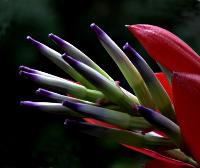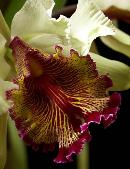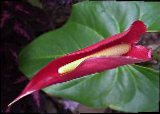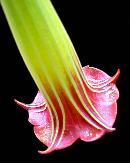
Page 2
Click images to enlarge
I returned to Colombia thinking of Burle Marx's example and proceeded to buy an old house, called "Tegualda," of nostalgic English architecture amid well established woods. It had been the country retreat, then subsequently, the year-round home of a former President of Colombia, Miguel Abadía Méndez, of infamous memory. In 1928 during his term of office hundreds of workers were massacred by the Colombian army during a strike against the United Fruit Company. There I found, in the abandoned gardens that surrounded the house many trees, including a large Araucaria excelsa which Abadía had probably brought back from Chile where he had been Colombia's Ambassador, and some orchids.
 And
from that time onwards -- when climbing the mountains close to
the house was still safe -- I devoted myself to orchid hunting,
and with my friends began a fabulous adventure in learning that
continues to this day. The names of my teachers were: Martha
de Robledo, who has since taken refuge in the town of La Ceja
and Francisco Villegas (whose wife Ana Patricia is my accomplice
in Bromeliads); while in Bogotá, I could always
count on the invaluable guidance -- spiritual and taxonomic --
of Pedro Ortiz, a quiet Jesuit savant, who knows how to be silent
in more than ten languages, both living and dead. He is also
an expert on Colombian orchid species, and the author of an excellent
translation into everyday Spanish of the New Testament completely
free of any pomposity. Our interchanges (almost always by E-mail)
usually go like this: "Father, I was taught that a whale
swallowed Jonas but the Bible says it was a fish." And Father
Ortiz, filled with a master's condescension replies: "True.
But elsewhere in the Bible the birds are counted and the listing
includes bats, which are mammals just like whales are. In biblical
times there was no differentiation."
And
from that time onwards -- when climbing the mountains close to
the house was still safe -- I devoted myself to orchid hunting,
and with my friends began a fabulous adventure in learning that
continues to this day. The names of my teachers were: Martha
de Robledo, who has since taken refuge in the town of La Ceja
and Francisco Villegas (whose wife Ana Patricia is my accomplice
in Bromeliads); while in Bogotá, I could always
count on the invaluable guidance -- spiritual and taxonomic --
of Pedro Ortiz, a quiet Jesuit savant, who knows how to be silent
in more than ten languages, both living and dead. He is also
an expert on Colombian orchid species, and the author of an excellent
translation into everyday Spanish of the New Testament completely
free of any pomposity. Our interchanges (almost always by E-mail)
usually go like this: "Father, I was taught that a whale
swallowed Jonas but the Bible says it was a fish." And Father
Ortiz, filled with a master's condescension replies: "True.
But elsewhere in the Bible the birds are counted and the listing
includes bats, which are mammals just like whales are. In biblical
times there was no differentiation."
 |
Heliconia rostrata |
 Anthurium just opening |
 |
| < Cattleya aurea lip |
Brugmansia > |
I was fondly inclined towards orchids, but also involved in a heavy flirtation on the side with Heliconias, Araceas and Bromeliads, not to mention my love for the Melastomataceae. But this normalcy did not last and one day remembering the Victorias I had seen in New York I was seized by a crazy desire to grow the Victoria amazonica. This entailed first of all learning the correct name, not the more common designation Victoria regia, that Sir Robert Schomburgk, the second person to discover this plant, had recommended when he transmitted the drawings and description of the plant he'd found in British Guiana to Lindley, the English botanist. This combination of the queen's name and regia constituted a self-serving double compliment.
One of the first things I turned up was an account by the priest Enrique Pérez Arbeláez, relating how Thaddäus Haenke, a German national in the service of the Spanish Crown -considered by many to be the true discoverer of this marvelous plant- fell on his knees in the bottom of his canoe, giving thanks to God for allowing him to behold such incomparable beauty. This incident took place on the Marmoré River, a tributary of the Amazon. Months later he must have found an even more beautiful Victoria, the sight of which once again drove him to kneel in worship, this time on the rim of his light canoe, which overturned causing him to drown.
There's considerable confusion about who was really the first
European to see the Victoria. Some authors consider Aimé
Bonpland, who accompanied Baron von Humboldt on his travels,
to be the first, but as he did not publish his findings as is
de rigueur in the scientific world, Poeppig, a German
botanist born in Leipzig, has the honor, even though, when he
saw the plant he mistook it for an Asian species, Euryale
ferox, that doesn't grow in the Americas, and named it Euryale
amazonica. When all the documentation from Poeppig and Schomburgk
reached England and the realization dawned that the Euryale
and the Victoria regia were one and the same, then it
was decided to name the plant Victoria amazonica. There's
only one other species known, named Victoria cruziana
in honor of General Santa Cruz, that grows in Argentina, Bolivia
and Paraguay.
 With
all this background I decided to immerse myself in this new endeavor.
All I needed was seeds, know-how and a suitable climate, the
latter being the biggest and most difficult obstacle to overcome.
The know-how was supplied first via the Internet and then in
person by Kit and Ben Knotts. This husband and wife team has
the most beautiful water garden that I have ever seen, not far
from the sea in Cocoa Beach, a few miles south of Cape Canaveral,
Florida. One of their many ponds is called, appropriately enough,
"Reflection". This couple is very generous with their
knowledge, plants, seeds and hospitality. On one occasion when
I was staying with them, as a friendly gesture they prepared
for me some of Victoria's seeds which our Indians used
to eat as a snack. Bonpland reported that the Indians used to
collect these seeds and sell them.
With
all this background I decided to immerse myself in this new endeavor.
All I needed was seeds, know-how and a suitable climate, the
latter being the biggest and most difficult obstacle to overcome.
The know-how was supplied first via the Internet and then in
person by Kit and Ben Knotts. This husband and wife team has
the most beautiful water garden that I have ever seen, not far
from the sea in Cocoa Beach, a few miles south of Cape Canaveral,
Florida. One of their many ponds is called, appropriately enough,
"Reflection". This couple is very generous with their
knowledge, plants, seeds and hospitality. On one occasion when
I was staying with them, as a friendly gesture they prepared
for me some of Victoria's seeds which our Indians used
to eat as a snack. Bonpland reported that the Indians used to
collect these seeds and sell them.